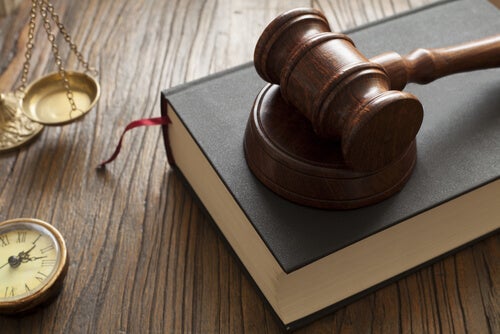What's the Purpose of Bail?

The main purpose of bail is to ensure that the accused is controlled by a specific legal process. The accused is so controlled that, at a later date, it can be judged if they complied with the conditions or not.
We can define bail as somewhere between total freedom and a prison sentence. Lawyers understand this concept as a personal precautionary measure.
It’s also important to keep in mind that bail always depends on the acceptance of certain obligations.

Why is someone given bail?
As we mentioned above, bail is a precautionary measure. A judge imposes it when they’re reasonably sure that the accused has committed the crime in question. In order to keep tabs on the accused before the trial, and even during the trial, a judge will apply measures such as provisional imprisonment or detention. There’s often a considerable restriction on the person’s freedom and freedom of movement.
However, it isn’t always necessary to impose such severe measures. When the judge considers that the accused isn’t likely to flee, they’ll agree on other measures. They also do this to avoid other unnecessary expensive options such as provisional detention.
A judge will make a decision according to the specific situation. For example, foreign detainees are unlikely to be granted bail. Specifically, because the risk of them going into hiding is greater.
The legal aspects and purpose of bail
The legal framework of bail can differ from country to country but tends to follow a similar procedure.
The main characteristics of bail are:
- Instrumental. This is because there’s a link between the crime and the accused and it serves as a preventive measure.
- Provisional and changeable. This is because changes can occur and alternative measures can be taken at any time during the process.
- Jurisdictional. Only judges can make decisions about what precautionary measures to take.
- Temporary nature. This is because bail changes or finishes when the actions that provoked it change.
This last feature is especially important. This is because a judge must release the accused if they turn out to be innocent, thus ending the precautionary measures.

Obligations of being on bail
At the time of ordering bail, the courts can demand a payment or bond. A judge will decide this according to the nature and seriousness of the crime, the person’s social status, and their background. The courts may also withhold the person’s passport or driving license.
In certain situations, the accused has to appear before a judge periodically. This is a control measure that a court can order. A judge will decide on the frequency of these appearances.
Similarly, the courts also have the power to confiscate the accused’s property or items. It’s important to note that this isn’t a precautionary measure as such, although it does have a preventive purpose.
The main purpose of bail is to ensure that the accused is controlled by a specific legal process. The accused is so controlled that, at a later date, it can be judged if they complied with the conditions or not.
We can define bail as somewhere between total freedom and a prison sentence. Lawyers understand this concept as a personal precautionary measure.
It’s also important to keep in mind that bail always depends on the acceptance of certain obligations.

Why is someone given bail?
As we mentioned above, bail is a precautionary measure. A judge imposes it when they’re reasonably sure that the accused has committed the crime in question. In order to keep tabs on the accused before the trial, and even during the trial, a judge will apply measures such as provisional imprisonment or detention. There’s often a considerable restriction on the person’s freedom and freedom of movement.
However, it isn’t always necessary to impose such severe measures. When the judge considers that the accused isn’t likely to flee, they’ll agree on other measures. They also do this to avoid other unnecessary expensive options such as provisional detention.
A judge will make a decision according to the specific situation. For example, foreign detainees are unlikely to be granted bail. Specifically, because the risk of them going into hiding is greater.
The legal aspects and purpose of bail
The legal framework of bail can differ from country to country but tends to follow a similar procedure.
The main characteristics of bail are:
- Instrumental. This is because there’s a link between the crime and the accused and it serves as a preventive measure.
- Provisional and changeable. This is because changes can occur and alternative measures can be taken at any time during the process.
- Jurisdictional. Only judges can make decisions about what precautionary measures to take.
- Temporary nature. This is because bail changes or finishes when the actions that provoked it change.
This last feature is especially important. This is because a judge must release the accused if they turn out to be innocent, thus ending the precautionary measures.

Obligations of being on bail
At the time of ordering bail, the courts can demand a payment or bond. A judge will decide this according to the nature and seriousness of the crime, the person’s social status, and their background. The courts may also withhold the person’s passport or driving license.
In certain situations, the accused has to appear before a judge periodically. This is a control measure that a court can order. A judge will decide on the frequency of these appearances.
Similarly, the courts also have the power to confiscate the accused’s property or items. It’s important to note that this isn’t a precautionary measure as such, although it does have a preventive purpose.
All cited sources were thoroughly reviewed by our team to ensure their quality, reliability, currency, and validity. The bibliography of this article was considered reliable and of academic or scientific accuracy.
- “Derecho Jurisdiccional III, Proceso Penal”. Moreno Aroca, J., Gómez Colomer, J.L., Barona Vilar, S., Esparza Leibar, I., Etxebarría Guridi, J.F.
- Ley de Enjuiciamiento Criminal, artículos 528 al 544. https://www.boe.es/buscar/act.php?id=BOE-A-1882-6036.
This text is provided for informational purposes only and does not replace consultation with a professional. If in doubt, consult your specialist.







